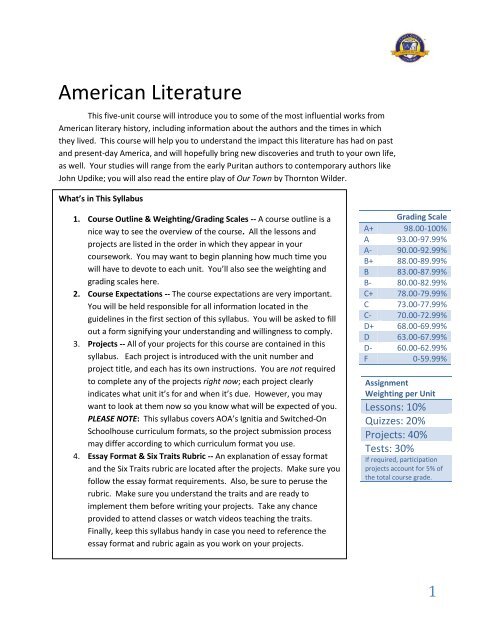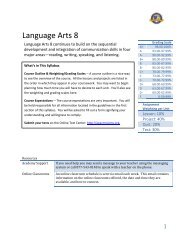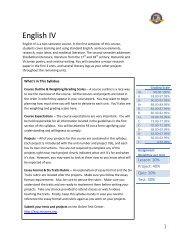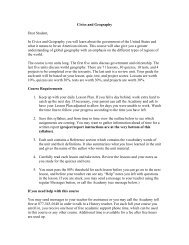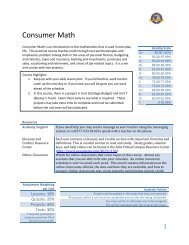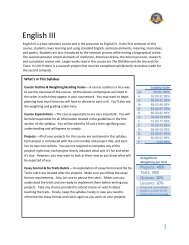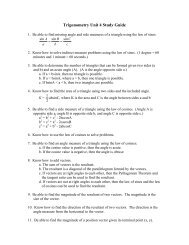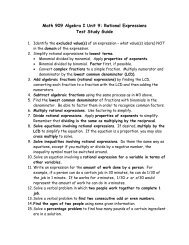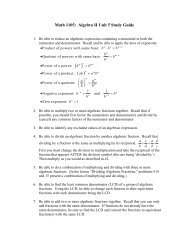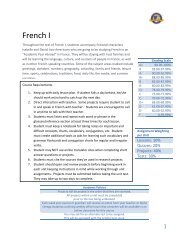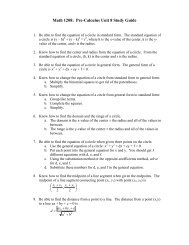American Literature - Alpha Omega Academy
American Literature - Alpha Omega Academy
American Literature - Alpha Omega Academy
You also want an ePaper? Increase the reach of your titles
YUMPU automatically turns print PDFs into web optimized ePapers that Google loves.
<strong>American</strong> <strong>Literature</strong>This five-unit course will introduce you to some of the most influential works from<strong>American</strong> literary history, including information about the authors and the times in whichthey lived. This course will help you to understand the impact this literature has had on pastand present-day America, and will hopefully bring new discoveries and truth to your own life,as well. Your studies will range from the early Puritan authors to contemporary authors likeJohn Updike; you will also read the entire play of Our Town by Thornton Wilder.What’s in This Syllabus1. Course Outline & Weighting/Grading Scales -- A course outline is anice way to see the overview of the course. All the lessons andprojects are listed in the order in which they appear in yourcoursework. You may want to begin planning how much time youwill have to devote to each unit. You’ll also see the weighting andgrading scales here.2. Course Expectations -- The course expectations are very important.You will be held responsible for all information located in theguidelines in the first section of this syllabus. You will be asked to fillout a form signifying your understanding and willingness to comply.3. Projects -- All of your projects for this course are contained in thissyllabus. Each project is introduced with the unit number andproject title, and each has its own instructions. You are not requiredto complete any of the projects right now; each project clearlyindicates what unit it’s for and when it’s due. However, you maywant to look at them now so you know what will be expected of you.PLEASE NOTE: This syllabus covers AOA’s Ignitia and Switched-OnSchoolhouse curriculum formats, so the project submission processmay differ according to which curriculum format you use.4. Essay Format & Six Traits Rubric -- An explanation of essay formatand the Six Traits rubric are located after the projects. Make sure youfollow the essay format requirements. Also, be sure to peruse therubric. Make sure you understand the traits and are ready toimplement them before writing your projects. Take any chanceprovided to attend classes or watch videos teaching the traits.Finally, keep this syllabus handy in case you need to reference theessay format and rubric again as you work on your projects.Grading ScaleA+ 98.00-100%A 93.00-97.99%A- 90.00-92.99%B+ 88.00-89.99%B 83.00-87.99%B- 80.00-82.99%C+ 78.00-79.99%C 73.00-77.99%C- 70.00-72.99%D+ 68.00-69.99%D 63.00-67.99%D- 60.00-62.99%F 0-59.99%AssignmentWeighting per UnitLessons: 10%Quizzes: 20%Projects: 40%Tests: 30%If required, participationprojects account for 5% ofthe total course grade.1
Unit 3: War and Reconciliation, 1855-1915Assignments1. Project: Unit 3 11. William Dean Howells2. Secession and Loyalty, 1855-1865: Introduction 12. Henry James3. Frederick Douglass 13. Quiz 2: Realism and Naturalism4. Harriet Beecher Stowe 14. Naturalists, Regionalists, and Realists: StephenCrane5. Spirituals 15. Kate Chopin6. Robert E. Lee 16. Paul Laurence Dunbar7. Abraham Lincoln 17. Jack London8. Quiz 1: Secession and Loyalty 18. Quiz 3: Naturalists, Regionalists, and Realists9. Realism and Naturalism, 1865-1915:19. Test: War and ReconciliationIntroduction10. Samuel Langhorne Clemens (Mark Twain) 20. ReferenceUnit 4: The Modern Age, 1915-1946Assignments1. The Modern Age 10. W.H. Auden2. Modern Prose: Ernest Hemingway 11. Quiz 2: Modern Poetry3. F. Scott Fitzgerald 12. Other Modern Age <strong>Literature</strong>: HarlemRenaissance, Langston Hughes4. Quiz 1: The Modern Age 13. Drama: Thornton Wilder5. Modern Poetry: Ezra Pound 14. Religious Works: J. Gresham Machen6. Carl Sandburg 15. Quiz 3: Other Modern Age <strong>Literature</strong>7. E.E. Cummings 16. Test: The Modern Age8. Wallace Stevens 17. Reference9. Robert FrostUnit 5: From Modern to Postmodern, 1946-PresentAssignments1. The Birth of Postmodernism: Introduction 10. Quiz 2: More Contemporary Writers2. Flannery O’Connor (1) 11. Social Issues: Martin Luther King, Jr.3. Flannery O’Connor (2) 12. Ralph Ellison4. Flannery O’Connor (3) 13. Gwendolyn Brooks5. Theodore Roethke 14. Quiz 3: Social Issues6. Quiz 1: The Birth of Postmodernism 15. Test: From Modern to Postmodern7. More Contemporary Writers: Eudora Welty 16. Course Survey <strong>American</strong> <strong>Literature</strong>8. John Updike 17. Reference9. Robert Trail Spence Lowell, Jr.3
<strong>American</strong> <strong>Literature</strong> Course ExpectationsPlease read this agreement with your supervising adult. Thank you! We’re looking forward toworking with you this year!Before you begin this course, make sure that you bookmark the student resources page, here:http://www.aoacademy.com/kb/?c=88. This will be a great reference source for you as you work,so make sure to refer back to it often.The information in this agreement is for your student’s benefit and guidance as he/she works through his/herEnglish class. Your student will be held accountable to remember and adhere to these policies; returning thecompleted form found in your coursework indicates that the information has been understood and that thesupervising adult and student intend and agree to comply with the policies. Adhering to these policies will help thestudent be successful in his/her learning goals.Daily Lessons Please take a moment to read Studying Techniques on the AOA resource center.As Studying Techniques indicates, it will be extremely beneficial for you to take notes as youread and study your daily lessons. Read your lessons carefully before attempting to answer thelesson questions. The lesson questions are for your benefit – so you can be sure you haveunderstood the concepts and ideas in the lesson. If you find yourself “hunting” for too manyanswers you may not have comprehended the lesson sufficiently; go back and study the ideasand concepts in your lesson more before proceeding with the questions.Do EVERYTHING in the lesson. This includes playing games, watching videos, listening to theaudio files, and, most importantly, clicking on the links provided. Several of your lessons cannotbe completed if you do not click on these links, so be sure to watch for them.When you get a lesson question wrong, pay close attention to that question. Having the chanceto answer it again gives you a chance to LEARN that concept more fully. Don’t just go searchingfor the right answer. It’s important to understand the concept behind the question. It’s not atall uncommon for quizzes and tests to contain material that is similar to daily lesson questions.By ignoring “missed questions” on lessons, you may be setting yourself up to miss any similarquestions on quizzes and tests.Be aware that you may not always be able to find an answer word for word in the text. As youenter into higher level courses, it is expected that you will take your understanding and applyyour knowledge to various situations. You will need to make connections based on what youhave learned, not simply hunt for answers in the text.All lesson questions must be completed. Lesson questions show your comprehension andunderstanding of the concepts in the lesson. This is especially true of questions which require asentence or paragraph answer.Answer in complete sentences with proper punctuation, grammar, and spelling. Points will bededucted for spelling or grammatical mistakes.4
Copying material from the lessons into the lesson answer boxes is not appropriate. Students arerequired to phrase answers in their own words.Copying material from outside webistes is a violation of AOA’s Academic Integrity policy, anddoing so will result in serious consequences.Understand that you might be tested over anything in a lesson.A list of vocabulary terms and definitions will be available at the beginning of each lesson, so useit as a study tool.If you are running stuck on grammar concepts, try one or more of the sites listed on a documentcontaining many Writing and Grammar Tools found on the resource center:http://www.aoacademy.com/kb/?a=379Self tests/quizzes and tests: Self tests/quizzes and tests are closed book; no study materials, notes, or any other informationare allowed during the assessment.Think about a student taking a quiz or test in a brick and mortar school building. Once a studentsits down to take a quiz or test, he/she is not allowed to move until after handing in that quiz ortest. In the same way, you need to be serious and conscientious about your time andsurroundings when you take a quiz or test for your AOA schoolwork.o Do not open tests until you are ready and have studied thoroughly.o Do not open a test if you do not have sufficient time to dedicate to finishing it. Testsshould be taken in one sitting; do not exit the test or leave it before finishing it. If youleave the test open for too long, it will automatically close, and it will be graded as is.You will not be able to finish your test or change any answers.Self tests/quizzes- Self tests and quizzes are comprehensive; the student may be tested on any materialcovered thus far in that unit.Tests- Tests may cover everything in your unit. You will have only once chance to complete a test,so be sure you are prepared before taking it.- Alternate tests may be taken if you desire. Please contact the <strong>Academy</strong> if you would like totake an alternate test. (The two test scores will be averaged together.)Projects: Project expectations: Essays and assignments must be the student’s original creations,generated single-handedly by the student. Work may not have been submitted previously for agrade at <strong>Alpha</strong> <strong>Omega</strong> <strong>Academy</strong>, or any other school. No plagiarized, incoherent, incomplete, ordistasteful assignment will be accepted. Similarly, assignments may not mention, or refer to, anyoffensive, violent, illegal, disparaging or inappropriate language (including, but not limited to,words that are widely considered offensive to individuals of a certain race, ethnicity, or religion);5
promote the abuse of alcohol, illegal drugs, or tobacco ; or promote any activities that mayappear unsafe or dangerous.Assignments that violate these expectations may be reassigned to the student with a 20% gradededuction. Plagiarized work will be handled according to the <strong>Alpha</strong> <strong>Omega</strong> <strong>Academy</strong> plagiarismpolicy.Projects may be reassigned to the student for any of the following reasons:- The instructions were not followed completely.- MLA documentation is missing or incorrect.- The teacher requested changes be made to the project, and the student resubmittedthe work without making the requested changes.- Some projects will be part of a multi-step process (For example – writing a thesisstatement and an outline for a five paragraph essay, finding your sources for a researchpaper, etc.). Projects which are part of a multiple-step process should be submitted oneat a time and in the given order. Not being submitted as such may result in a gradededuction.If a project has been reassigned for any of the above reasons, it may receive a 20% gradededuction.Projects are 40% of your unit grade; it is very important to do your best on them.Projects are not optional. Every project must be completed to the satisfaction of the teacher.The formatting of your projects is important and it counts toward your grade. Projects must besubmitted with heading information – which includes your name, the date, your teacher’s name,and the class in the upper left corner of the first page of your assignment. See below for moreinformation on how to format your projects.When you first start each unit, read through all the directions for any projects in that unit sothat you will be prepared to complete them.Projects are not meant to be completed in a matter of minutes. Work on them as you workthrough your unit, being careful to follow all directions.Written projects may take longer to grade than lessons or tests. Be assured that your teacherswill grade your work as soon as possible. Projects will be graded in the order in which they arereceived.After your project has been graded, go back to the file you uploaded to look for your teacher’sfeedback. This feedback is very important for improving your writing skills and doing better onyour next project. If you do not know how to access the graded file, please call the language artsdepartment.Academic Support: You can find your teacher’s schedule for when they are available in their online office hoursusing the Gradebook on your DashboardStudents are encouraged to get academic support by contacting their teachers when they needassistance on their lessons. This is the best way to complete your participation projects6
Be specific in your correspondence and communication with your teacher. (“I need help” is notspecific.) The better your teacher understands your problem, the quicker he or she will be ableto help you.Be polite and scholarly in your correspondence and communication with your teacher. Useproper spelling, grammar, and punctuation in all of your academic dealings with your teachers.Texting abbreviations or spellings are not acceptable or appropriate.Any message or email that you send to your teacher is expected to have a greeting (“Dear Mr. orMs. [Teacher’s last name]”) and signed with your name.Teachers cannot help students during tests and quizzes, although they can clarify what aquestion is asking if you are confused.<strong>American</strong> <strong>Literature</strong> ProjectsAMERICAN LITERATUREUnit 2: The Romantic Period 1800-1855This is your project for this entire unit. Read the instructions now so you can prepare to dothis project well. It should be completed after you have learned about the material related tothe project’s topic. The project is due before you take your test.Purpose: As you reflect upon the material you studied for this unit, it’s helpful to respond in acreative way. As you respond, you will find yourself becoming more certain of your opinion andimpressions of the work. You will also understand better how writing and literature has an effecton the culture around them.Here is your goal for this assignment:Respond to literature in a creative manner.Instructions: You have three options for this project. Please read through the options and pickone to finish.Option A: Book CoverCreate a book cover for one of the selections in this unit. The book cover can be in astyle that is reminiscent of the time period, or it may be designed to appeal to modern7
eaders. Whatever style you choose, make sure that you incorporate the selection’sthemes, ideas, images, mood, etc. into the book cover. For example, if the selection has aslightly dark feeling, include dark colors and images on the cover, like a run-down houseor graveyard.Option B: PosterCreate a poster for one of the themes in the unit. Themes that would work well for aposter include the transcendental movement, the fireside poets, and the poets of despair.If you have your own idea of a theme from this unit, make sure you ask your teacherabout it before you start your project. This option will be similar to the book coveroption in that you need to incorporate the selection’s ideas and moods as well as themeinto the final project. One way this could easily be done is by finding a good summaryquote of the theme and placing it in an eye-catching location on the poster.Option C: AdvertisementCreate an advertisement for one of the authors or selections. You want to make such acompelling ad that a viewer would feel that they had to immediately go read the selectionor the author’s works. This ad will be in the form of either print (like in a newspaper ormagazine), marketing piece (flyers, handouts, or display board), or a video ad (such asyou would see on TV).Here’s an interesting example of a video ad/trailer some people created for theirinterpretation of Edgar Allen Poe’s “The Raven”:http://www.youtube.com/watch?v=JO2RGpdIdt0.Notice how even though the setting is modern times, the filmmakers put a dark, eerie, andgripping feel into their trailer to faithfully represent Poe’s writing as well as to stirinterest in a viewer’s mind.Meet the following requirements and use the Six+1 Traits rubric to guide you as you workon your project. You’ll be graded according to the Six+1 Traits rubric. These are creative pieces, so you can be as creative as you want while maintaining aproper respect and analysis of the literature at hand. Colors, images, quotes, pictures, etc.are encouraged! Include details in whichever option you choose to show you understand the selection,author, or literary movement. You want the viewer to see your project and believe thatyou know your selection very well because you represented it in such a professional andcreative way. If you have access to an image-editing program like Adobe Photoshop or Paint Shop Pro,these are excellent options to use in creating your piece. If you are going to make a videoadvertisement, Windows Movie Maker is a simple program that often comes free on newcomputers; other video-editing software that are not always free but are high-quality areAdobe Premiere, Final Cut, and Avid. Sometimes libraries will even have these8
programs installed on their computers; call your local library to find out.If an image or video-editing program is not available, you can easily draw, paint, or“scrapbook” your piece by cutting images and letters out of magazines and newspapersand pasting them onto a piece of colored cardboard or construction paper.Title your project with a creative title (something like “Whitman’s Poems” is boring anddoesn’t make anyone want to look at your piece!).Submission: You will need to submit your project in one of the following ways.1. Take a clear, well-lit picture of your project or scan it into your computer with ascanner (often available at a library). Save your project as an image file in .jpeg/.jpgformat. Saving as a .pdf file is also easy with the right program. Send this file toyour teacher in an e-mail, making sure you clarify that the project is for <strong>American</strong><strong>Literature</strong> unit 2.2. Another alternative for submitting your scanned/created image file is to copy andpaste (or insert) your image file into the unit 2 project. Save and submit as younormally would for a project.3. Another option, with permission from your parent(s), is to upload your file to anonline image or file-hosting website, such as Google Docs or Flickr. This will benecessary especially if you created a video advertisement; this MUST beuploaded to a video-hosting website like YouTube. Copy and paste the link toyour image into the unit 2 project. Save and submit as you normally would for aproject. Your teacher will click the link to view your project.Do you have a different idea for completing this project? Message your teacher about it andrequest to do that instead!AMERICAN LITERATUREUnit 3: War and Reconciliation 1855-1915This is your project for this entire unit. Read the instructions now so you can prepare to dothis project well. It should be completed after you have learned about the material related tothe project’s topic. The project is due before you take your test.Purpose: To deepen your understanding of literature, you will be analyzing selections from thisunit according to the selections’ situations, cultures, and contexts/settings. One of the best waysto learn about literature and its importance is to participate in these contexts set forth by theauthor and apply the authors’ ideas to your own life and writing.Here are your goals for this assignment:9
Analyze literary selections for authors’ use of language and dialect, and theirpurpose for doing so, or…Write in response to literature and its historical setting.Instructions: You have two options for this project. Please read through the options and pickone to finish.Option A: Dialect/LanguageWriting the way a character speaks is not a common practice among authors, butsometimes it can add a whole new level of depth to their works. In this project, you willinvestigate this use of dialect and language used by Mark Twain and Paul LaurenceDunbar through two different steps. Both steps must be completed for you to receive fullcredit!Step One: Create a Word Cloud- Choose two or three prime examples of regional dialect and language quotes fromboth Twain and Dunbar.- Go to http://www.wordle.com.- Click on the “Create” tab.- Type or paste your dialect/language quotes in the first text box and then click “Go.”- Once the words are generated, play around with their look using the “Language,”“Font,” “Layout,” and “Color” options. You can also click “Randomize” to get arandom look.- Once you are satisfied with the way your words look, click “Save to public gallery.”Enter a title for your piece (preferably something with Twain and Dunbar’s names init), and enter your name and any comments you may have.- Your word cloud is finished. Find the code the website gives you underneath yourcloud and copy and paste it into this file, after all of these project instructions.Step Two: Write a Short ResponseStarting on the next line after your pasted code, write a short analysis essay about MarkTwain and Paul Laurence Dunbar’s use of dialect and language. How do their writingsuse regional dialect and language? Why did the writers choose to use this technique?What effect does this have on their writing? How does this technique differ from thewriting of early <strong>American</strong> settlers and the Romantic artists in previous years?Meet the following requirements and use the Six+1 Traits rubric to guide you as youwrite your essay. You will be graded according to the Six+1 Traits rubric. This is an analysis essay, so it must be academic in nature and not include any personal opinions, thoughts, or references. You must cite at least one direct quotation from each author in your essay to support10
your discussion of his work. If you use any other outside sources, be sure to includeone quote from each of these as well (NOTE: Wikipedia is NOT a valid source andwill not be accepted). You must include parenthetical citations and a works cited page in MLA format. Use what you've learned about well-developed paragraphs and effective transitions;this is an academic piece so you want the reader to be able to follow your ideassmoothly. Be sure your report is free of conventional and grammatical errors. There is no word count requirement; instead you want to aim for concisely developingyour ideas, with no rambling or unnecessary/repetitive information. If you want ageneral word count guideline, a project of this type tends to be about 300-400 words. After you write your essay, take a break from it (this could be a few hours or a fewdays). Come back to your essay with fresh eyes. Read your essay aloud to yourself orto another person. Does it clearly show what you want your reader to understand?Revise and edit as necessary.Option B: Being a SlaveUsing My Bondage and My Freedom by Frederick Douglass and Uncle Tom’s Cabin byHarriet Beecher Stowe as guiding examples, write a diary entry from the viewpoint ofbeing a slave in America before the Civil War (even though some slaves couldn’t write,imagine you could). Decide what kind of experience you will have: an oppressed lifeunder a cruel master, or a relatively fear-free life under a more caring master. How doyou react to things that happen to you? What would you want to change about your life ifyou could? What do you think of the situation of other slaves whose lives are differentthan yours? Make sure you comment on Frederick Douglass’ situation as if you knewhim, and also tie in Tom and Cassy’s situations in a creative way.Meet the following requirements and use the Six+1 Traits rubric to guide you as youwork on your diary entry. You will be graded according to the Six+1 Traits rubric. This is a creative piece, so you can be as creative as you want while maintaining aproper respect and analysis of the literature at hand. Include pictures, charts, quotes,etc. to enhance the meaning of your writing, if you so wish! Use what you've learned about well-developed paragraphs and effective transitions;this is a creative piece but you still want the reader to be able to follow your ideassmoothly. Be sure your writing is generally free of conventional and grammatical errors, but feelfree to write in the dialect of a slave to make your writing more impactful. There is no word count requirement; instead you want to aim for concisely developingyour ideas, with no rambling or unnecessary/repetitive information. If you want ageneral word count guideline, a project of this type tends to be about 400-500 words. After you write your entry, take a break from it (this could be a few hours or a fewdays). Come back to your entry with fresh eyes. Read your diary entry aloud to11
yourself or to another person. Does it clearly show what you want your reader tounderstand? Revise and edit as necessary.Do you have a different idea for completing this project? Message your teacher about it andrequest to do that instead!Essay Format RequirementsAs a reminder, all typed work in English I must adhere to these format requirements as stated inthe Language Arts Course Expectations agreement (unless specifically stated otherwise in aproject’s directions or by your teacher):‣ Margins of the page should be one inch on all sides.‣ Typed projects must be written using Times New Roman 12-point font or Arial 12-point font.‣ Font must be black in color.‣ Typed projects must be double-spaced, including the title.‣ Header: Your name, the teacher’s name, the class and assignment, and the date shouldbe the first thing to appear on the page. These should be listed in that order in the upperleft corner of the page.‣ Title: Title your paper appropriately and center the title in the middle of the page.‣ Start your writing after the title. Writing should always be aligned with the left side ofthe page (unless you are indenting the first line). Writing should never be centered likethe title.‣ All new paragraphs must be indented by hitting the “Tab” button on your keyboard, orby pressing the spacebar five times.‣ If MLA format is required for the project, all sources and parenthetical citations must bewritten in the most current version of MLA format.12
Any typed work that does not meet these requirements could be deducted points and couldreduce your overall grade for that work.Six+1 Traits RubricSome of your projects in English I will be graded according to the Six+1 Traits Rubric. If acertain trait is not applicable to the project type, the teacher will not provide a grade for that traitand it will not be factored into your final grade.Trait 5 3 1This paper is clear and focused. Itholds the reader’s attention.Relevant anecdotes and detailsenrich the central theme.The writer is beginning to definethe topic, even thoughdevelopment is still basic orgeneral.The paper has no clear sense ofpurpose or central theme. Thereader must make inferences basedon sketchy or missing details.Ideas: Themain messageof the piece,the theme,withsupportingdetails thatenrich anddevelop thattheme.1. The topic is narrow andmanageable.2. Relevant, telling, quality detailsgo beyond the obvious.3. Ideas are crystal clear andsupported with details.4. Writing from knowledge orexperience; ideas are fresh andoriginal.5. Reader’s questions areanticipated and answered.6. Insightful topic.1. The topic is broad.2. Support is attempted.3. Ideas are reasonably clear.4. Writer has difficulty going fromgeneral observations about topicto specifics.5. The reader is left withquestions.6. The writer generally stays ontopic.1. The writer is still in search of atopic.2. Information is limited or unclearor the length is not adequate fordevelopment.3. The idea is a simple restatementor a simple answer to the question.4. The writer has not begun todefine the topic.5. Everything seems as important aseverything else.6. The topic may be repetitious,disconnected, and containing toomany random thoughts.Organization:The internalstructure,thread ofcentralmeaning,logical, andsometimesintriguingpattern orsequence ofideas.The organizational structure of thispaper enhances and showcases thecentral idea or theme of the paper;includes a catchy introduction anda satisfying conclusion.1. An inviting introduction drawsthe reader in; a satisfyingconclusion leaves the reader with asense of closure and resolution.2. Thoughtful transitions connectideas.3. Sequencing is logical andeffective.4. Pacing is well-controlled.5. The title, if desired, is original.6. Organizational structure isappropriate for purpose/audience;paragraphing is effective.The organizational structure isstrong enough to move the readerthrough the text without too muchconfusion.1. The paper has a recognizableintroduction and conclusion.2. Transitions sometimes work.3. Sequencing shows some logic,yet structure takes attention awayfrom the content.4. Pacing is fairly well-controlled.5. A title, if desired, is present.6. Organizational structuresometimes supports the main pointor story line, with an attempt atparagraphing.The writing lacks a clear sense ofdirection1. No real lead or conclusionpresent.2. Connections between ideas, ifpresent, are confusing.3. Sequencing needs work.4. Pacing feels awkward.5. No title is present (if requested).6. Problems with organizationalstructure make it hard for the readerto get a grip on the main point orstory line. Little or no evidence ofparagraphing present.13
Voice: Theuniqueperspective ofthe writerevident in thepiece throughthe use ofcompellingideas,engaginglanguage, andrevealingdetails.Word Choice:The use ofrich, colorful,and preciselanguage thatmoves andenlightens thereader.SentenceFluency: Therhythm andflow of thelanguage, thesound of wordpatterns, theway in whichthe writingplays to theear, not just theeye.Conventions:Themechanicalcorrectness ofthe piece;spelling,punctuation,capitalization,The writer of this paper speaksdirectly to the reader in a mannerthat is individual, compelling,engaging, and respectful for theaudience.1. Uses topic, details, and languageto strongly connect with theaudience.2. Purpose is reflected by contentand arrangement of ideas.3. The writer takes a risk withrevealing details.4. Expository or persuasive writingreflects understanding andcommitment to topic.5. Narrative writing is honest,personal, and engaging.Words convey the intendedmessage in a precise, interesting,and natural way.1. Words are specific and accurate.2. Striking words and phrasescreate imagery.3. Natural, effective, andappropriate language.4. Lively verbs, specific nouns, andmodifiers.5. Language enhances and clarifiesmeaning.6. Precision is obvious by choice ofwords and phrases.The writing has an easy flow,rhythm, and cadence. Sentencesare well-constructed.1. Sentences enhance the meaning.2. Sentences vary in length as wellas structure.3. Purposeful and varied sentencebeginnings.4. Creative and appropriateconnectives.5. The writing has cadence.The writer demonstrates a goodgrasp of standard writingconventions (e.g., spelling,punctuation, capitalization,grammar usage, paragraphing).1. Spelling is generally correct.2. Punctuation is accurate.3. Capitalization skills are present.The writer seems sincere, but notfully engaged or involved. Theresult is pleasant or evenpersonable, but not compelling.1. Attempt to connect withaudience is earnest butimpersonal.2. Attempts to include content andarrangement of ideas to reflectpurpose.3. Occasionally reveals personaldetails, but avoids risk.4. Expository or persuasivewriting lacks consistentengagement with topic.5. Narrative writing reflectslimited individual perspective.The language is functional, even ifit lacks much energy.1. Words are adequate and correctin a general sense.2. Familiar words and phrasescommunicate.3. Attempts at colorful language.4. Passive verbs, everyday nouns,mundane modifiers.5. Language functions, with oneor two fine moments.6. Occasionally, the words andphrases show refinement andprecision.The text hums along with a steadybeat, but tends to be morepleasant or businesslike thanmusical.1. Sentences get the job done in aroutine fashion.2. Sentences are usually of similarlength, yet constructed correctly.3. Sentence beginnings aresomewhat varied.4. The reader sometimes has tohunt for connective clues.5. Parts of the text inviteexpressive oral reading; otherparts may be stiff, awkward,choppy, or gangly.The writer shows reasonablecontrol over a limited range ofstandard writing conventions.1. Spelling is usually correct orreasonably phonetic on commonwords.2. End punctuation is usuallycorrect.The writer seems uninvolved withthe topic and the audience.1. Fails to connect with theaudience.2. Purpose is unclear.3. Writing is risk-free, with nosense of the writer.4. Expository or persuasive writingis mechanical, showing noengagement with the topic.5. Narrative writing lacksdevelopment of a point of view.The writer struggles with a limitedvocabulary.1. Words are nonspecific ordistracting.2. Many of the words don’t work.3. Language is used incorrectly.4. Limited vocabulary, misuse ofparts of speech.5. Language is unimaginative andlifeless.6. Jargon or clichés, persistentredundancy.The reader has to practice quite abit in order to give this paper a fairinterpretive reading.1. Sentences are choppy,incomplete, rambling, or awkward.Phrasing does not sound natural.2. No “sentence sense” is present.3. Sentences begin the same way.4. Endless connectives, if anypresent.5. Writing does not inviteexpressive oral reading.Errors in spelling, punctuation,capitalization, usage, and grammarand/or paragraphing repeatedlydistract the reader and make textdifficult to read.1. Spelling errors are frequent.2. Punctuation is missing orincorrect.14
grammarusage, andparagraphing.4. Grammar and usage are correct.5. Paragraphing tends to be sound.6. The writer may manipulateand/or edit for stylistic effect; and itworks!3. Most capitalized words arecorrect.4. Problems with grammar andusage are not serious.5. Paragraphing is attempted.6. Moderate, inconsistent editing(a little of this, a little of that).3. Capitalization is random.4. Obvious grammar or usageerrors.5. Paragraphing is missing.6. Little, if any, editing; the readermust read once to decode, thenagain for meaning.Presentation:The look of thepaper, properuse of MLAformattingwhennecessary,correct titlingand inclusionof projectinstructionsThe project is clean, has alldirections included, and MLAformat was used correctly ifneeded.1. Project directions precede theproject.2. Spacing is uniform and font isTimes New Roman or Arial 12point.3. In a multimedia project, use ofvisuals is integrated withoutdistraction.4. Correctly formatted citations andworks cited if outside sources wereused.May be some problems in theformatting.1. Project directions are included,but not placed correctly.2. There are some problems withfont or spacing.3. For multimedia, the visuals aresomewhat unclear or distracting.4. In those projects for whichoutside sources were used, MLAformatting is mostly correct.There may be some componentsmissing or improperly formatted.Errors in formatting create aconfusing paper that distracts thereader.1. Project directions are missing orincomplete.2. Spacing and font are notstandard.3. Visuals in a multimedia projectare confusing and substandard.4. Works cited page and/orparenthetical citations for thoseprojects where necessary aremissing or incorrect.*0 – Not a valid attempt. Student did not make the changes recommended by the teacher.15


